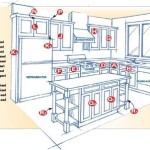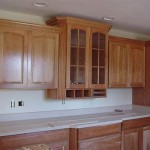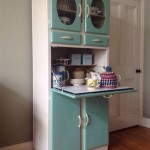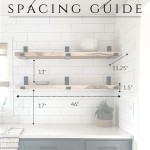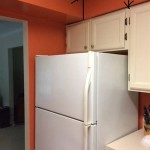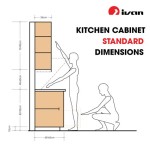Should White Kitchen Cabinets Be “In?” Timelessness and Trends in Kitchen Design
The question of whether white kitchen cabinets should be considered “in” or “out” is a recurring theme in interior design discussions. The reality is more nuanced than a simple yes or no answer. White kitchen cabinets possess qualities that transcend fleeting trends, making them a consistently popular choice for homeowners and designers alike. However, understanding the reasons behind their enduring appeal, as well as potential drawbacks and evolving design perspectives, is crucial for making informed decisions about kitchen aesthetics.
The longevity of white kitchen cabinets stems from their versatility and adaptability. White serves as a neutral backdrop, allowing homeowners to personalize their kitchen spaces through various design elements such as countertops, backsplashes, hardware, and accent colors. Unlike bolder or more trend-specific cabinet colors, white readily complements a wide range of styles, from traditional to contemporary, and can evolve alongside changing design preferences without requiring a complete remodel. This inherent flexibility contributes significantly to their sustained popularity.
Furthermore, white cabinets contribute to a brighter and more spacious-feeling kitchen. White reflects light, making smaller kitchens appear larger and more open. This is particularly beneficial in homes with limited natural light. The clean and crisp aesthetic associated with white also evokes a sense of cleanliness and order, qualities highly valued in a kitchen environment. These practical and psychological benefits further solidify white cabinets as a desirable option for many homeowners.
Despite their enduring appeal, the perception of white kitchen cabinets has shifted over time. While they remain a popular choice, the ubiquity of white kitchens in recent years has led some to perceive them as predictable or even sterile. This has prompted a move towards incorporating more color, texture, and unique design elements into kitchen spaces to create more personalized and expressive environments. Therefore, while white kitchen cabinets remain a viable option, achieving a truly stylish and contemporary kitchen requires careful consideration of how they are integrated with other design features.
Key Point 1: The Timelessness of Neutrality
The primary reason for the continued relevance of white kitchen cabinets lies in their neutral character. White acts as a blank canvas, allowing for endless design possibilities. This neutrality provides homeowners with the freedom to experiment with different colors, textures, and materials in other aspects of the kitchen without clashing or creating an overwhelming aesthetic. A vibrant backsplash, a richly veined countertop, or statement hardware can all be seamlessly integrated into a kitchen featuring white cabinets, creating a focal point and adding personality.
The ability to easily update and refresh the kitchen's overall look without replacing the cabinets is a significant advantage. Simply changing the hardware, paint color, or accessories can dramatically alter the feel of a white kitchen, making it a cost-effective and sustainable choice for homeowners who enjoy experimenting with different styles. In contrast, kitchens with bolder or more trend-specific cabinet colors may require more extensive renovations to remain current and visually appealing.
Moreover, the neutrality of white cabinets appeals to a broader range of potential buyers. When selling a home, a neutral kitchen is generally considered a safer bet, as it allows prospective buyers to envision their own style and design preferences in the space. A kitchen with highly personalized or unconventional cabinet colors may deter some buyers, potentially impacting the home's market value. This resale value consideration often influences homeowners' decisions when selecting kitchen cabinets.
Key Point 2: Maximizing Light and Space
Beyond its aesthetic versatility, white's reflective properties offer significant practical advantages, particularly in kitchens with limited natural light. White cabinets bounce light around the room, creating a brighter and more airy atmosphere. This is especially beneficial in smaller kitchens, where maximizing the perception of space is crucial. Darker cabinet colors, on the other hand, tend to absorb light, making a small kitchen feel even more cramped and enclosed.
The psychological impact of a bright and open kitchen should not be underestimated. A well-lit kitchen can enhance mood and productivity, making it a more enjoyable space to cook and socialize. White cabinets contribute to this sense of spaciousness and brightness, creating a more inviting and comfortable environment. This is particularly relevant in modern homes, where the kitchen often serves as the central hub for family activities.
Furthermore, white cabinets can visually minimize imperfections in the kitchen's architecture. Uneven walls or awkward angles may be less noticeable against a light, neutral backdrop. This can be a cost-effective alternative to extensive renovations aimed at correcting structural flaws. By employing white cabinets strategically, homeowners can create a more visually appealing and cohesive kitchen without incurring significant expenses.
Key Point 3: Avoiding the “Sterile” Look and Embracing Nuance
While the benefits of white kitchen cabinets are undeniable, it's crucial to acknowledge the potential for a sterile or impersonal aesthetic. An all-white kitchen, devoid of any contrasting colors, textures, or personal touches, can feel cold and uninviting. To avoid this, it's essential to incorporate elements that add warmth, character, and visual interest to the space.
One effective strategy is to introduce natural materials, such as wood countertops, butcher block islands, or woven textures. These elements inject warmth and organic appeal into the kitchen, counteracting the starkness of the white cabinets. Similarly, incorporating pops of color through accessories, artwork, or even appliance finishes can add personality and prevent the kitchen from feeling monotonous.
Another approach is to experiment with different shades and textures of white. Instead of opting for a bright, stark white, consider softer, warmer whites with subtle undertones. Matte or satin finishes can create a more subdued and sophisticated look compared to high-gloss finishes. Additionally, incorporating textured cabinet doors, such as shiplap or beadboard, can add visual interest and depth to the kitchen design.
Ultimately, the success of white kitchen cabinets hinges on careful planning and execution. By understanding the potential pitfalls and embracing creative design solutions, homeowners can create a kitchen that is both timeless and stylish, reflecting their personal taste and lifestyle. Ignoring the need for balance and visual interest can result in a kitchen that feels dated and uninspired, regardless of the inherent advantages of white cabinets.
The integration of natural stone countertops like granite or quartz, with their unique veining and patterns, provides a luxurious and visually striking counterpoint to the simplicity of white cabinets. The same principle applies to backsplashes: consider using textured tiles, patterned mosaics, or even a single bold color to create a focal point and add depth to the kitchen. Lighting plays a crucial role as well. Warm, layered lighting can soften the overall look and create a more inviting ambiance compared to harsh, overhead fluorescent lights.
Hardware choices also contribute significantly to the overall aesthetic. Brass, copper, or matte black hardware can add a touch of sophistication and contrast to white cabinets, while more contemporary chrome or stainless steel hardware can create a sleek and modern look. The key is to choose hardware that complements the overall design style and adds a personal touch.
Furthermore, the style of the cabinet door itself can dramatically impact the kitchen's overall feel. Shaker-style cabinets are a classic and versatile choice that works well in both traditional and contemporary kitchens. Raised-panel cabinets offer a more formal and traditional look, while flat-panel cabinets create a sleek and minimalist aesthetic. Consider the architectural style of the home and personal preferences when selecting cabinet door styles.
In conclusion, the enduring appeal of white kitchen cabinets stems from their versatility, ability to maximize light and space, and potential to complement a wide range of design styles. However, achieving a truly stylish and contemporary kitchen requires careful consideration of how white cabinets are integrated with other design elements. By incorporating contrasting colors, textures, and personal touches, homeowners can avoid the sterile look and create a kitchen that is both timeless and visually appealing.

How To Make Your Kitchen Beautiful With Pretty Cabinet Details Heather Hungeling Design
:strip_icc()/101956659-21295000cb54459c86f1e53f80388dd3.jpg?strip=all)
17 Stunning White Kitchen Cabinets That Will Brighten Your Space

How To Style Glass Kitchen Cabinets Sanctuary Home Decor

The Moment You Ve Been Waiting For Our White Kitchen Makeover Reveal Decor

Are White Kitchen Cabinets Going Out Of Style Ohanlonkitchens Com

Kitchen Cabinets White Or Greige At Home In Love

How To Make Your Kitchen Beautiful With Pretty Cabinet Details Heather Hungeling Design

How To Make Your Kitchen Beautiful With Pretty Cabinet Details Heather Hungeling Design

Cream And White Kitchens Happy Accident Or Stroke Of Genius

How To Re Paint Your Yucky White Cabinets
Related Posts

